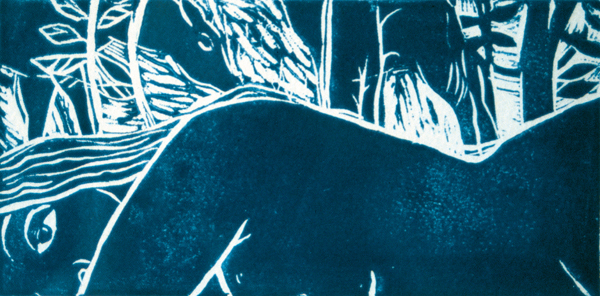

Human interactions in the Bible are on the whole seen from a certain distance. The paucity of narrative detail regarding setting, appearance and posture can make even the most intimate of conversations read like an exchange between talking heads. Physical contact between characters in the rapid narrative reports is usually reduced to the basest notation. One person may carry, grasp, seize, fling or strike another; in the sexual sphere, the man (almost always the subject of these verbs) may know, lie with or come into a woman.1 But that is all the reader learns. These summarized notations keep us at arm’s length from the narrated event.
The same is true in a somewhat different way of most biblical poetry. The power of the poetry found in the Bible inheres in its ability to express a variety of mounting intensities, a pattern that is encouraged by the structures of intensification that so often manifest themselves in the movement from one parallel member in a line of verse to the next. The poetry of the Prophets, and, in a partly related manner, the poetry of Job as well, is especially effective in evoking trajectories from breaking to smashing to pulverization, or, in an opposite direction of hyperbolic development, from mere national restoration to reapers overtaking sowers and mountains melting with sweet liquor. The poetry of Psalms is often remarkable in giving voice to great delicacy as well as great intensity of feeling—“As a deer longs for brooks of water, so my very self longs for you, O Lord” (Psalm 42:2).
Yet the poetry, no more than the narrative, scarcely offers us arresting images of the ultimate closeness—emotional, physical and explicitly sexual—that is realized between two people through love.
Almost every reader of the Song of Songs, however, senses that the representation of such closeness is precisely one of the most remarkable achievements of this poem. The development of this experience of closeness is a cumulative artistic process. It begins with the very first words of the poem.
All of the poetry in the Song of Songs is spoken by one of the two lovers (except for a few lines assigned to the daughters of Jerusalem and perhaps to the young woman’s brothers). But there is an alteration of actual dialogue between the two lovers (or at least direct address of one by the other) and narration. In the narration the loved one is absent and referred to by the other in the third person.
It is a timeless piece of literary wisdom that one of the best ways to represent an experience is by introducing a strongly contrastive evocation of its antithesis. The defining background for the memorable images of rapturous intertwining in the Song is provided by those two terrifying scenes of separation—the lover who flees into the night when his coy mistress does not promptly open the door for him and thus leads her to desperate pursuit (5:1–8); and the sleepless young woman longing for her lover, then setting out on her own in a breathless nocturnal search (3:2). When she finds him, after asking the night watchmen if they had seen him, she clings to him with all her might: “I held him, I would not let him go / until I brought him to my mother’s house, / into my mother’s room” (3:4). Why she insists on bringing him to this particular location is a matter to which we shall return.
The segue from third-person distance to second-person intimacy is beautifully traced in the first seven Hebrew words of the poem. I give a literal version instead of the admirable translation by Ariel and Chana Blocha in order to make this effect clear: “Let him kiss me with the kisses of his mouth, / for your loving is better than wine” (1:2). Though the grammar may sound a little strange in English, biblical Hebrew quite often glides from deferential third-person to second-person address with a concomitant switch, when necessary, to first-person singular for the speaker’s self-reference. Ariel Bloch aptly notes that the polite third-person form is characteristically used for addressing august personages and so may have been adopted here as part of the recurring trope, or fantasy, of the lover as king. In any case, the woman begins her first speech with a verb of intimate physical contact—yishaqeni, “let-him-kiss-me”—which is not allowed to remain merely a summarizing notation (as it is, for example, in Genesis 29:12, “And Jacob kissed Rachel and lifted his voice and wept”) because it is immediately followed by its cognate object, mineshiqot, “with-the-kisses,” and then the physical locus of the kisses, mipihu, “of-his-mouth.” Yet there is a hint of tension between the physical concreteness of the desired act—tongue to tongue and lip to lip—and the grammatical indirection of the third-person form, whether because the woman is casting her lover as king or because she wants him so intensely that, for a brief moment, she dares to invoke him only as an oblique, almost absent object of desire. Then, in the second half of the line, she crosses fully into the zone of intimacy, addressing her lover in the second person, and now, through the immediacy of the gustatory simile, revealing that she is in fact sweetly familiar with his embraces, for she confidently affirms that his loving, or lovemaking, dodim, is better than wine.
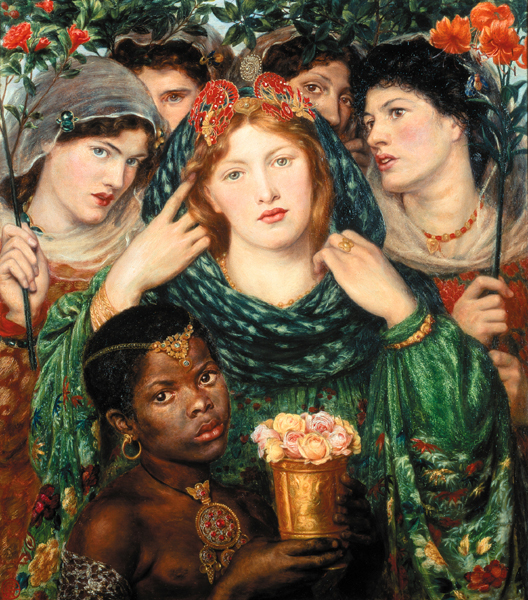
There is a striking connection between this evocation of, and passionate desire for, physical intimacy and the gender of the speaker. It should be noted that the Song of Songs begins with the woman’s speech (all of the first chapter and the initial verse of the second chapter) and concludes with her speaking in the very last verse of the book. Needless to say, each of the lovers wants to be close to the other, but a certain difference of emphasis manifests itself in the poetry that each of them speaks. The male lover is particularly fond of rhapsodizing about the body of his beloved as a beautiful spectacle. Thus: “You are beautiful, my love, as Tirzah / majestic as Jerusalem, daunting as the stars in their course.” Then the lover compares various parts of her body to animals and fruit (6:4–7). (She does this with his body, too, at one point, but only when challenged, in her response to the question from the daughters of Jerusalem, “How is your lover different from any other?” [5:9].) In one long and captivating sequence (4:1–5:1), he does imagine coming into her garden—implicitly, the luxurious garden of her body—but even that is preceded by a good deal of running across the landscape (the athletic lover of the Song does a considerable amount of skipping and running), while the profuse elaboration of the metaphor teasingly conceals her body in the very imagery of the fragrant bower that represents it.
When the young woman speaks, on the other hand, she very often expresses both the ache of separation and the ardent longing to have her lover nestled in her arms, in a private place where no one will disturb them. I do not want to commit that deadliest contemporary intellectual sin of essentializing gender roles, but it does seem that the Song plays with an archetypal, perhaps even evolutionary, opposition between male and female. The young man, a gatherer rather than a hunter in this pacific world, goes bounding over hill and dale, is repeatedly figured as a wild stag, and invites the young woman to join him in an expedition to vernal vineyards. She, on the other hand, often associates herself with houses and inner chambers (hadarim) and, of course, with beds. Though in one scene we behold her dancing, her preferred condition is the untroubled physical closeness of shared repose. Her language near the very beginning of the poem establishes the key for much of what follows: “My king lay down beside me / and my fragrance wakened the night. / All night between my breasts / my love is a cluster of myrrh, / a sheaf of henna blossoms / in the vineyards of Ein Gedi” (1:12–14). The wonderful miniaturization of the lover as a fragrant sachet, either attached by a thong round her neck or simply tucked between her breasts, vividly expresses her passionate fantasy of having her lover always, unfailingly close to her, almost a part—or at least an accoutrement—of her body. If the outside world enters into this fantasy through the phrase “in the vineyards of Ein Gedi,” it is only in a fleeting doubletake that we may imagine the lovers actually embracing in those vineyards, for the reference seems to be to the place where the henna blossoms grow, whereas the night of love that she conjures up is enjoyed in her bed and presumably in her house.
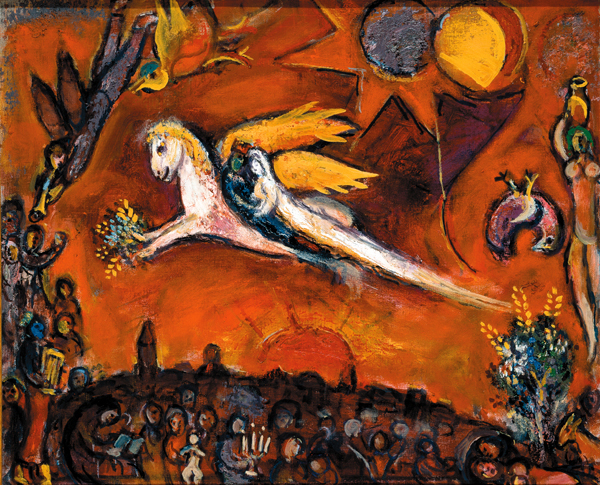
The contrast I have sketched between the male and female voices in the poem is slightly overstated because both the man and the woman are minutely attentive in their language, in ways not typical of biblical poetry elsewhere, to the sensuous immediacy of taste and smell, here interwoven metaphorically and metonymically with the physical closeness of the two lovers, as when he says to her, “Your lips are honey, honey and milk / are under your tongue, / your clothes hold the scent of Lebanon” (4:11). She often speaks to him in the same manner, as when, having likened him to an apricot tree (as the Blochs identify it), she goes on to say, “In that shade I have often lingered, / tasting the fruit” (2:3). (The literal sense of the Hebrew is rather more concretely anatomical: “In its shade I was desirous [or, I desired its shade], and its fruit was sweet to my palate.”) The very prelude to that wrenching nocturnal moment when the lover will flee from the as-yet barred door is a visual close-up altogether rare in biblical poetry, an image that, with its suggestive sense of sexual double meaning, poignantly concentrates the possibility of amorous intimacy that is about to be shattered: “I rose to open to my love, / my fingers wet with myrrh, / sweet flowing myrrh / on the doorbolt” (5:5).

It is, of course, both right and necessary that the young man as well as the young woman should delight in the intimate taste and smell of love’s pleasures. Without the mutuality of desire, the celebration of the joy of love that is the subject of the Song would scarcely be possible. And yet, there is a note of difference in her association with the experience of merging and with inner space and his association with energetic movement and with all outdoors. The opening lines of the last chapter of the Song, spoken by the woman, constitute a climactic constellation of the longings for closeness that she has repeatedly expressed before:
If only you were a brother
who nursed at my mother’s breast!
I would kiss you in the streets
and no one would scorn me.I would bring you to the house of my mother
and she would teach me.
I would give you spiced wine to drink,
my pomegranate wine.His left hand beneath my head,
his right arm
holding me close. (8:1–3)
It strikes me as a misdirection of the reader’s attention to seek institutional warrants, such as the brother-sister marriages of the Egyptian royal family, for this “incestuous” gesture. The young woman articulates a blissful dream of perfect, uninterrupted union with her lover, fantasizing him as a sibling or perhaps even a twin, a perfect soul-mate. (He, of course, speaks to her in the same vein, though without the vivid elaboration of the idea she offers, when he addresses her in 4:9 as “my sister, my bride.”) The implicit opposition in these lines between the maternal house and the streets is paramount to the thematics of intimacy in the Song. The public space of the social realm imposes, necessarily and understandably, a decorum of separation between persons, prohibiting the embraces reserved for bedroom or sheltered bower. The young woman can scarcely bear the notion of being separated from her lover’s embrace and so invents the alluring fantasy of the two of them as brother and sister, free to continue their kisses in the bright light of the public square.
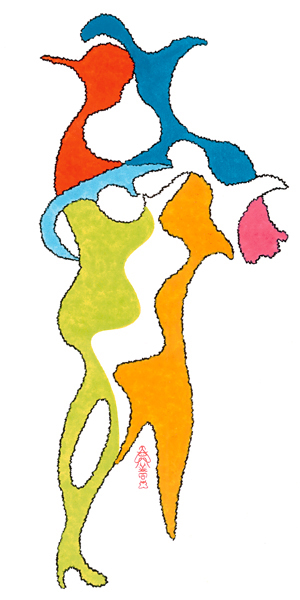
What is especially noteworthy is that she concretizes the fraternal bond as an image of her lover suckling her mother’s breast. The nurturing contact between infant and mother is, of course, our primal and, as many have argued, psychologically defining experience of physical closeness. A deep current of related emotion runs between this image of the babe at the breast and that earlier image of the lover as a sachet of myrrh nestled all night long between his beloved’s breasts. Although the young woman here entertains a fleeting notion of being free to kiss her man out in the streets, the next lines make clear that where she really wants him is in her mother’s house. Elsewhere in biblical literature, the invariable reference is to the “father’s house” (beit ’av), which is both a concrete place and a technical name for a fundamental social unit in this patriarchal society.b In the Song, on the other hand, quite remarkably, there are no fathers in view. The young woman takes her lover to her mother’s house because that is the place where the good breast was once proffered, the first model for all later appetite and love. And if the Masoretic textc is dependable here in reading telamdeini, “she would teach me,” the mother who once provided physical nurture can now give her daughter instruction in the arts of love—a practice, as Ariel Bloch notes, for which there are ancient Near Eastern precedents. Society and even the extended family are here displaced not merely by the nuclear family but by the most biologically intimate bond within the nuclear family, the bond between mother and child.
If the Song begins, as we have seen, in a rapid glide from the distance of third person to the intimacy of second person, in this passage near the end of the poem there is a complementary movement in the opposite direction, for a reason that is worth considering. The young woman, having imagined bringing her lover to the safe enclosure of her mother’s house, announces, in a playful ambiguity characteristic of the poem, “I would give you spiced wine to drink, / my pomegranate wine.” Perhaps she is simply offering him delicious and intoxicating drink as an act of hospitality, but given the metaphorical equivalence between wine and lovemaking established from the very beginning of the poem, and given the punning link between ’ashqekha, “I would give you drink,” and ‘eshaqkha, “I would kiss you,” she is probably proposing to him other delights. Now that she has him, at least in the wishful mood of the verbs she has been using, in the intimate space of the inner chamber of her mother’s house, she can turn to an audience in the public space and present an exulting narrative report, in the third person, of the perfect closeness she enjoys in her lover’s embrace: “His left hand beneath my head, / his right arm holding me close.” The identity of those she is addressing is made explicit in the next verse: “Daughters of Jerusalem, swear to me / that you will never awaken love / until it is ripe.” This adjuration of the daughters of Jerusalem, which has already appeared twice in the poem, seems to be an effort to ward off any exhortations to love until the two young people feel that their moment of readiness has arrived. But at this juncture—the lover imagined in the mother’s house and the mother prepared to instruct her daughter—that moment has manifestly come. What is essential, especially in regard to the Song’s overriding concern with the lovers’ intimacy, is that the daughters of Jerusalem are representatives of the social realm. That realm, which is a world of conventions, divisions, restrictions and collective expectations, can have no real understanding of or access to the inner sanctum where the lovers hold each other close, reconstituting in their passion the sustaining bodily closeness of mother and child.
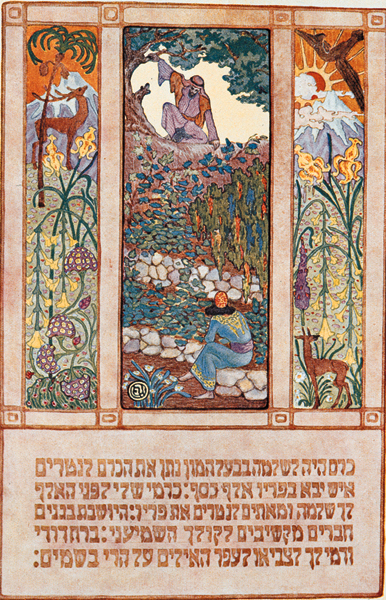
The very last words of the Song, spoken by the young woman, move outdoors again, but with a delicate tracing of the interplay between distance and closeness that has run through the whole poem. “Hurry my love!” she urges her lover. “Run away, / my gazelle, my wild stag / on the hills of cinnamon.” The reiterated image of the lover as gamboling stag propels us from house or garden (the latter is the locus of the immediately preceding line) to the open landscape. But that landscape may be just as metaphorical as the stag. Many readers have puzzled over why the beloved should tell her lover at the very end of the poem to run away—or even, given the force of the Hebrew verb she uses, berah, to flee from her. Ariel Bloch proposes, reasonably enough, that she is urging him to flee as dawn breaks after their night of love, with the clear implication that they will soon be rejoined. Since, however, fragrant mountains and hills have earlier been invoked as metaphors for the intimate parts of the woman’s body, the intention of this final image may be to carry us at once in two opposite directions: On the figurative surface, the lover is exhorted to go bounding off to the distant mountains; in the tenor of the metaphor, he is invited to hurry to the body-as-landscape where the pleasures of the inner chamber await him. That delectable to-and-fro movement between distance and closeness, between the mountains of the Lebanon range and the enclosed garden of the beloved, is an imaginative signature that makes the Song of Songs one of the most abidingly delightful love poems in the Western canon.
MLA Citation
Footnotes
Ariel and Chana Bloch, The Song of Songs: A New Translation (New York: Random House, 1995; repr. Berkeley, CA: Univ. of California Press, 2000). All translations used here, unless otherwise noted, are from this translation, ©2002 The Regents of the University of California.
See the following articles in Biblical Archaeology Review: Lawrence E. Stager, “The Song of Deborah—Why Some Tribes Answered the Call and Others Did Not,” BAR 15:01; and Philip King and Stager, “Of Fathers, Kings and the Deity,” BAR 28:02.
Endnotes
The last of these terms, bo’ ’el, “come into,” might seem to have a certain anatomical concreteness, but the way it is repeatedly used argues that it had become a fixed idiom in biblical usage for a man’s first experience of sexual intimacy with a woman, bearing only a vestigial connection with the physical origins of the expression.

